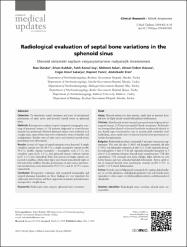Radiological evaluation of septal bone variations in the sphenoid sinus

View/
Access
info:eu-repo/semantics/openAccessDate
2014Author
Dündar, RızaKulduk, Erkan
Soy, Fatih Kemal
Aslan, Mehmet
Kılavuz, Ahmet Erdem
Sakarya, Engin Umut
Yazıcı, Haşmet
Eren, Abdülkadir
Metadata
Show full item recordAbstract
Amaç: Sfenoid sinüste yer alan septum, optik sinir ve internal karotid arter ile ilgili olarak varyatif durumların belirlenmesi. Yöntem: Akut/kronik sinüzit tanısıyla paranasal sinüs bilgisayarlı tomografi istenen 218 hasta retrospektif olarak taranmıştır. Bu hastaların tomografileri aksiyel ve koronal kesitlerde incelenerek sfenoid sinüs, kemik septa varyasyonları, sayı ve uzanım şekli yönünden sınıflandırılmış, ayrıca optik sinir ve internal karotid arter protrüzyon valansları hesaplanmıştır. Bulgular: Radyolojik inceleme sonucunda 5 tip septa varyasyonu saptanmıştır. Yüz otuz iki adet (%60,5) tek komplet septumlu, 66 adet (%30.2) tek inkomplet septumlu, 6 adet (%2.7) çift septumlu (komplet+inkomplet), 9 adet (%4.1) çift septumlu (komplet+komplet) ve 5 adet (%2.2) septumu olmayan sfenoid sinüs tanımlanmıştır. Tek olan septumların %64 oranında orta hatta olduğu, diğer tiplerin ise orta hattın hemen sağ veya solundan başladığı izlenmiştir. Ayrıca optik sinir ve internal karotid arter protruzyon oranları (n=39) 17.8% ve (n=61) %27.9 olarak bulunmuştur. Sonuç: Cerrahi öncesi bilgisayarlı tomografi ile yapılan değerlendirme ve cerrahi planlama, endoskopik girişimler için çok büyük önem taşımakta ve olası majör cerrahi komplikasyonların azaltılmasında rol almaktadır. Objective: To determine septal variations and rates of intrasinusal protrusions of optic nerve and internal carotid artery in sphenoid sinus. Methods: Retrospective analysis of spiral computed tomography scanning of paranasal sinuses of 218 patients diagnosed as acute/chronic sinusitis was performed. Bilateral sphenoid sinuses were evaluated as if a single sinus, septa of this sinus were evaluated in terms of number and configuration. Besides rates of optic nerve and internal carotid artery protrusions were determined. Results: A total of 5 types of septal variations were detected. A single complete septum (n=132; 60.5%), a single incomplete septum (n=66; 30.2%), double septum (complete + incomplete, n=6; 2.7%), two complete septa (n=9; 4.1%), and sphenoid sinuses without septum (n=5; 2.2%) were identified. Sixty-four percent of single septum was located in midline, while other types were found immediately right or left side of the midline. Besides, protrusions of optic nerve and internal carotid artery were detected in 39 (17.8%) and 61 (27.9%) cases, respectively. Conclusion: Conclusion: Preoperative evaluation with computed tomography and surgical planning dependent on these findings are very important for endoscopic interventions and these approaches minimize potential major intraoperative complications.
Source
Journal of Medical UpdatesVolume
4Issue
1Collections
Related items
Showing items related by title, author, creator and subject.
-
Prevalence and etiological causes of sinus headache in 113 consecutive patients with chronic rhinosinusitis
Kaymakçı, Mustafa; Gür, Özer Erdem; Pay, Güneş (Yüzüncü Yıl Üniversitesi Tıp Fakültesi, 2014)The aim of this article is to examine the prevalence and etiological causes of sinus headache in patients with chronic rhinosinusitis. Patients who complained of sinus headache were identified and their presenting symptoms ... -
Yarım-sinüs ve dikdörtgen darbeler kullanarak minimum-kaydırmalı anahtarlama sinyallerinin üretilmesi
Yakut, Serkan (2016)Minimum-kaydırmalı anahtarlama sinyalleri, ikili sürekli-fazlı frekans-kaydırmalı anahtarlama sinyallerinin özel bir formu olarak görülebilir. Yarım-sinüs darbeler veya dikdörtgen darbeler kullanarak minimum-kaydırmalı ... -
Maxillary sinus aeration in allergic rhinitis
Kaymakçı, Mustafa; Erel, Fuat; Bülbül, Erdoğan; Yazıcı, Haşmet; Acar, Mustafa; Yanik, Bahar (Lippincott Williams & Wilkins, 2015)Objective: We aimed to investigate the relationship between allergic rhinitis, which is an important reason of nasal obstruction, and maxillary sinus aeration. Patients and Methods: Three hundred fifteen patients who have ...

















